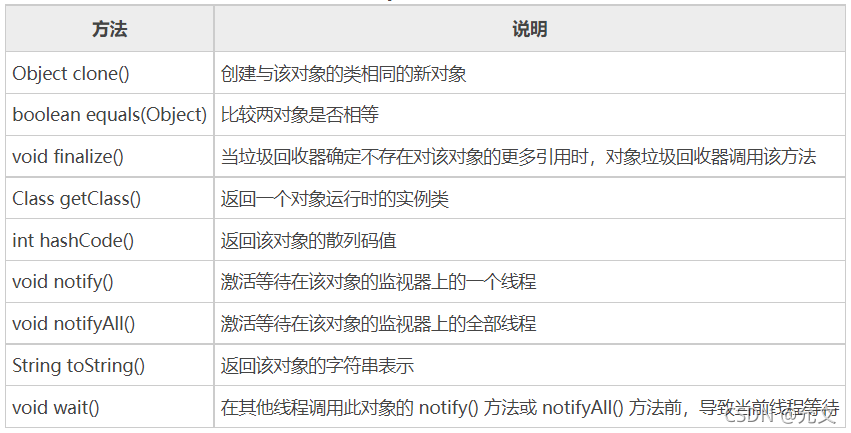java基础之路:常用类的常用方法
文章目录
前言
很多人对与常用类的常用方法不能一一熟悉,这对于程序员而言是一件痛苦的事情,我总结了一下几种常用类。
Object类的常用方法
Object类的常用方法如下:

import java.util.Scanner;
public class Test01 {
// 验证用户名和密码
public static boolean validateLogin(String uname, String upwd) {
boolean con = false;
if (uname.equals("admin") && upwd.equals("admin")) { // 比较两个 String 对象
con = true;
} else {
con = false;
}
return con;
}
public static void main(String[] args) {
Scanner input = new Scanner(System.in);
System.out.println("------欢迎使用大数据管理平台------");
System.out.println("用户名:");
String username = input.next(); // 获取用户输入的用户名
System.out.println("密码:");
String pwd = input.next(); // 获取用户输入的密码
boolean con = validateLogin(username, pwd);
if (con) {
System.out.println("登录成功!");
} else {
System.out.println("用户名或密码有误!");
}
}
}
public class Test02 {
public static void printClassInfo(Object obj) {
// 获取类名
System.out.println("类名:" + obj.getClass().getName());
// 获取父类名
System.out.println("父类:" + obj.getClass().getSuperclass().getName());
System.out.println("实现的接口有:");
// 获取实现的接口并输出
for (int i = 0; i < obj.getClass().getInterfaces().length; i++) {
System.out.println(obj.getClass().getInterfaces()[i]);
}
}
public static void main(String[] args) {
String strObj = new String();
printClassInfo(strObj);
}
}
String API常用方法介绍
1)char charAt (int index)
返回给定位置的代码单元。除非对底层的代码单元感兴趣,否则不需要调用这个方法。
2)int codePointAt(int index) 5.0
返回从给定位置开始的码点。
3)int offsetByCodePoints(int startIndex,int cpCount) 5.0
返回从 startIndex 代码点开始,位移 cpCount 后的码点索引。
4)int compareTo(String other)
按照字典顺序,如果字符串位于 other 之前,返回一个负数;如果字符串位于 other 之后,返回一个正数;如果两个字符串相等,返回 0。
5)IntStream codePoints() 8
将这个字符串的码点作为一个流返回。调用 toArray 将它们放在一个数组中。
6) new String(int[] codePoints, int offset, int count) 5.0
用数组中从 offset 开始的 count 个码点构造一个字符串。
7)boolean equals(Object other)
如果字符串与 other 相等,返回 true。
8)boolean equalsIgnoreCase(String other)
如果字符串与 other 相等(忽略大小写)返回 true。
9)boolean startsWith(String prefix)
10)boolean endsWith(String suffix)
如果字符串以 suffix 开头或结尾,则返回 true。
11)int indexOf(String str)
12)int indexOf(String str, int fromIndex)
13)int indexOf(int cp)
14)int indexOf(int cp, int fromIndex)
返回与字符串 str 或代码点 cp 匹配的第一个子串的开始位置。这个位置从索引 0 或 fromIndex 开始计算。如果在原始串中不存在 str,返回 -1。
15)int lastIndexOf(String str)
16)int lastIndexOf(String str, int fromIndex)
17)int lastIndexOf(int cp)
18)int lastIndexOf(int cp, int fromIndex)
返回与字符串 str 或代码点 cp 匹配的最后一个子串的开始位置。这个位置从原始串尾端或 fromIndex 开始计算。
19)int length()
返回字符串的长度。
20)int codePointCount(int startIndex, int endIndex) 5.0
返回 startIndex 和 endIndex-1 之间的代码点数量。没有配成对的代用字符将计入代码点。
21)String replace(CharSequence oldString, CharSequence newString)
返回一个新字符串。这个字符串用 newString 代替原始字符串中所有的 oldString。可以用 String 或 StringBuilder 对象作为 CharSequence 参数。
22)String ?substring(int beginIndex)
23)String substring(int beginIndex, int endIndex)
返回一个新字符串。这个字符串包含原始字符串中从 beginlndex 到串尾或 endlndex-1 的所有代码单元。
24)String toLowerCase()
25)String toUpperCase()
返回一个新字符串。这个字符串将原始字符串中的大写字母改为小写,或者将原始字符串中的所有小写字母改成了大写字母。
26)String trim()
返回一个新字符串。这个字符串将删除了原始字符串头部和尾部的空格。
27)String join(CharSequence delimiter, CharSequence… elements) 8
返回一个新字符串,用给定的定界符连接所有元素。
File类(文件操作类)详解

public class Test02 {
public static void main(String[] args) {
String path = "C:/windows/"; // 指定文件所在的目录
File f = new File(path, "notepad.exe"); // 建立File变量,并设定由f变量引用
System.out.println("C:\\windows\\notepad.exe文件信息如下:");
System.out.println("============================================");
System.out.println("文件长度:" + f.length() + "字节");
System.out.println("文件或者目录:" + (f.isFile() ? "是文件" : "不是文件"));
System.out.println("文件或者目录:" + (f.isDirectory() ? "是目录" : "不是目录"));
System.out.println("是否可读:" + (f.canRead() ? "可读取" : "不可读取"));
System.out.println("是否可写:" + (f.canWrite() ? "可写入" : "不可写入"));
System.out.println("是否隐藏:" + (f.isHidden() ? "是隐藏文件" : "不是隐藏文件"));
System.out.println("最后修改日期:" + new Date(f.lastModified()));
System.out.println("文件名称:" + f.getName());
System.out.println("文件路径:" + f.getPath());
System.out.println("绝对路径:" + f.getAbsolutePath());
}
}
TreeSet类的常用方法

Collection接口的常用方法

StringBuffer类常用的方法
- append(数据类型 变量)
将参数的值转换成字符串,再添加到当前字符串尾,然后将其返回
- delete(int start,int end)
在当前字符串中,删除从下标start开始到下标end-1的字符,然后返回
- deleteCharAt(int index)
删除当前字符串下标为index的字符,然后返回
- insert(int offset,数据类型 变量)
将参数的值转换成字符串,并插入到当前字符串下标为offset的位置处
- replace(int start,int end,String str)
将字符串从下标start开始至下标end-1之间的字符串替换为str字符串
- reverse()
将字符串反转
还有charAt(int index),length(),substring(int start),substring(int start, int end)
这几个方法和String类对应的方法功能相同
Scanner类
1)构造方法
Scanner(InputStream is)
构造一个文本扫描器,它生成的值是从指定的值输入流扫描的
System.in 是一个标准的输入流,属于InputStream
2)成员方法
boolean hasNext():是否有下一个数,有true,没有false
String next():获取下个数
int nextInt():获取下个int数据
String nextLine():获取一行数据